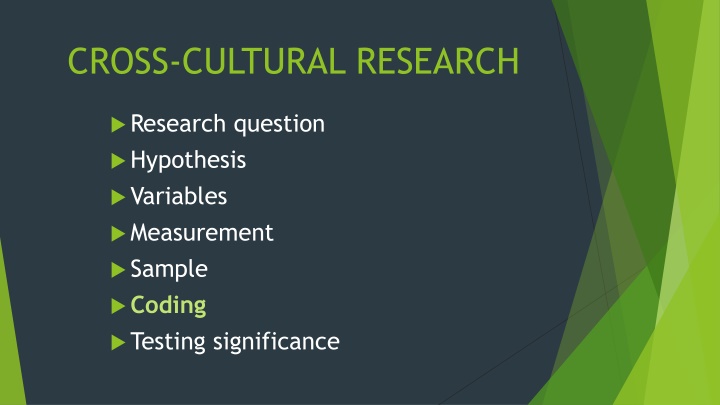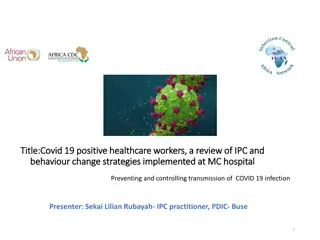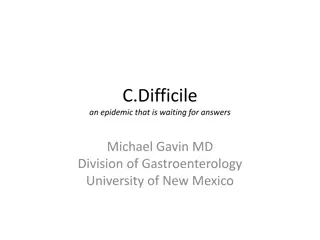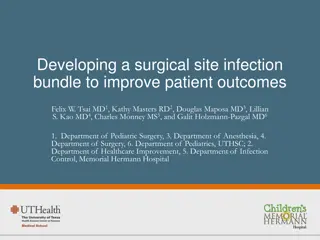Impact of Family Structure on COVID-19 Infection Rates
This study explores the relationship between family organization, sleeping arrangements, and infection rates during the COVID-19 pandemic. Hypotheses suggest higher infection rates in larger households, extended families, and families sharing sleeping spaces. By analyzing these variables, the research aims to uncover patterns influencing the spread of the virus within family units.
Download Presentation

Please find below an Image/Link to download the presentation.
The content on the website is provided AS IS for your information and personal use only. It may not be sold, licensed, or shared on other websites without obtaining consent from the author.If you encounter any issues during the download, it is possible that the publisher has removed the file from their server.
You are allowed to download the files provided on this website for personal or commercial use, subject to the condition that they are used lawfully. All files are the property of their respective owners.
The content on the website is provided AS IS for your information and personal use only. It may not be sold, licensed, or shared on other websites without obtaining consent from the author.
E N D
Presentation Transcript
CROSS-CULTURAL RESEARCH Research question Hypothesis Variables Measurement Sample Coding Testing significance
QUESTION TYPES FOR RESEARCH TOPICS Descriptive: Prevalence of a trait Causal: Causes of a trait Consequence: Effects of a trait Association: Nondirectional relationship between traits
Family Structure and COVID-19 Infection After the age of thirty, your chances of dying if you get COVID-19 doubles roughly every eight years How does the population pyramid of Pakistan compare with that of Italy?...[Even so] Mexico has a median age similar to India s Yet, India s reported rate of COVID-19 deaths per capita is less than a tenth of Mexico s So perhaps other populational features are significant. Take, for instance, the structure of an individual family and its living arrangements: who cohabitates with whom? Since the virus is often spread by close contact among family members a grandchild infects a grandmother we might want to find how often the elderly are found in multigenerational dwellings. --Siddhartha Mukherjee, The covid conundrum: Why does the pandemic seem deadlier in some countries than in others? The New Yorker, March 1, 2021
THEORY, HYPOTHESES & LAWS A theory is an idea (or system of ideas) that aims to explain a phenomenon or phenomena. In cross- cultural research, theories often attempt to explain diversity or universality of particular cultural phenomena or traits. An hypothesis is an explicit, concrete prediction (usually derived from theory) that can be statistically tested. Laws are verified hypotheses.
TYPES OF HYPOTHESES Theoretical abstract Operational includes measures Null Alternative
VARIABLES Independent Family organization and sleeping arrangements Dependent Infection rates
HYPOTHESES We expect to find higher infection rates in communities with larger household size, in other words, H1: the larger the household, the higher the infection rate We expect to find higher infection rates in extended families and multigenerational households, in other words, H2: stem and joint families will have higher infection rates. We expect to find higher infection rates in families that sleep together in the same bed or room, in other words, H3 families whose members share the same bed will have higher infection rates.
MEASUREMENT Nominal discrete sets Ordinal degree of dependence Interval scale of equidistant points, e.g., temperature Ratio scale with true zero point, e.g., Population density
ORDINAL MEASUREMENT Very high Moderately high Moderately low Infrequent or rare Don t know
SAMPLE Probability Sample Files (PSF) Simple Random Sample Standard Cross-Cultural Sample (SCCS)
CODE SHEET Society name, I.D., time and place foci, coder, date Main ethnographers/works referenced, ethnographic present Statement about the variables and how the information was gathered Data quality codes Code definitions Coding
DATA QUALITY For Data Quality Scores (DQ) use the following: 1. Ethnographer discusses this realm clearly and unambiguously and the information refers to a general cultural pattern. 2. Information refers to a general cultural pattern, but is somewhat ambiguous. 3. Information is anecdotal and based on just one or a few households. 4. Other reason to consider it problematic but useful information. Explain. 5. Detailed discussion on subject but not specific enough to answer question with certainty. All ratings should be made for the time focus (and if possible the place focus). If there is a departure from this, note in the data quality score under "Other."
CODE SHEET CS-XXX-Covid Conundrum Family Organization and Sleeping Arrangements Society Name (in SCCS)__________ Time Focus (-15 + 10 years) _____ SCCS-ID_____OWC____Place Focus _____________ Coder ____Date________Who was/were the focal ethnographer(s) used to code this case?__________________________ Does the data used to code this case match the SCCS ethnographic present?______________________________________ If the data does not match the SCCS ethnographic present, what time period was rated?____________________________ This group of variables is concerned with family organization and sleeping arrangements. Family organization is coded by Murdock (1967), Column 14 of the Ethnographic Atlas. The variable sleeping arrangement refers to family members who sleep together in the same room. Search the eHRAF World Cultures using the OCM 513, Sleeping . 1. What is the code for Family Organization, Column 14 in Murdock s Ethnographic Atlas? _______________ 2. Do family members share the same bedroom? (1=Whole family sleeps in one room; 0.5=Some family members sleep in the same room; 0= family members sleep in separate rooms. 88= Confusing information; 99= Not enough information to code.)_______; 2-DQ______. 3. Do family members share the same bed? (1=Whole family shares the same bed; 0.5=Some family members share the same bed; 0=Family members each have their own bed; 88= Confusing information; 99= Not enough information to code.)_______; 2-DQ________. 2. Does the whole family sleep in the same room? (2=all the time; 1=some of the time; 0=rarely or never; 88= confusing information; 99= not enough information to code.)_____________DQ_____________. 3. Do family members sleep in the same bed? (2=all the time; 1=some of the time; 0=rarely or never; 88= confusing information; 99= not enough information to code.)_____________DQ_____________.
METHODS FOR DISCREPANCY RESOLUTION 1.Using only one coder s ratings. 2.Summing or averaging codes. 3.Resolution method. 4.Dropping serious disagreements.























